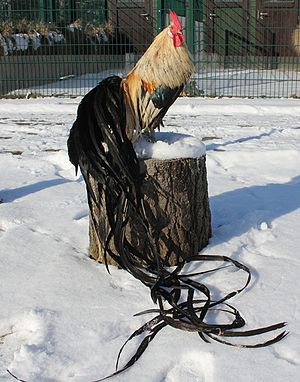Onagadori
| Onagadori | |||||
|---|---|---|---|---|---|
|
|||||
| Origin: | Japan | ||||
| Colour: | Gold-necked, silver-necked, orange-necked, black, white | ||||
| Weight: | • Rooster: 1.5 kg. • Hen: 1 kg |
||||
| Laying output per year: | up to 60 eggs | ||||
| Eggshell color: | Yellowish white | ||||
| Egg weight: | 40 g | ||||
| Breeding standards: | BDRG | ||||
| List of breeds of chicken | |||||
Onagadori ( Japanese 尾 長 鶏 "long-tailed chicken ") are the only pedigree chickens recognized by the Association of German Pedigree Poultry Breeders that do not molt their tail and saddle or parts of them because of the special Gt gene, or only moult every few years . They are therefore counted among the long-tailed chickens .
Genetically, the tail continues to grow into old age and can be up to 14 meters long. Onagadori can live up to 20 years when traditionally kept.
However, the property of unlimited tail growth is no longer found everywhere today, as the gene pool is now very small due to the ban on exporting and importing animals from Japan . For this reason, the genetics of other long-tailed breeds such as Shokoku or Totenko are sometimes used , which is a problem for European and Japanese breeding, as the animals are very closely related there too.
Today it is no longer easy to find a pure, original Japanese Onagadori that really does not moult its tail. The Japanese onagadori must not be confused with the phoenix , as these animals have fundamentally different properties in terms of tail growth and shape. The two races can be distinguished particularly well by their body shape. Phoenix are tubular, so very elegant, while Onagadori, on the other hand, correspond more to the country chicken type and have a more powerful shape and clearly defined breast. The color of the feet, which is blue-gray in Phoenix and yellowish to willow-green in Onagadori, is a clear indication of racial unity.
In general, onagadori are not the best laying hens. Their breeding instinct is moderate.
The long-tailed chickens in Tosa have been classified as a special natural monument of Japan since 1952 .
Web links
- Yokohama Chickens. poultrykeeper.com., Retrieved January 6, 2017 .
- Onagadori - a living legend! In: Longtail fowl & Long crowers of the World. Retrieved January 6, 2017 .
- Onagador breeding in Germany. In: Onagadori.de. Retrieved January 16, 2017 .
Individual evidence
- ↑ 特別 天然 記念 物 土 佐 の オ ナ ガ ド リ . (PDF) 南国 教育 委員会 , October 17, 2007, accessed on January 6, 2017 (Japanese, with many images).

